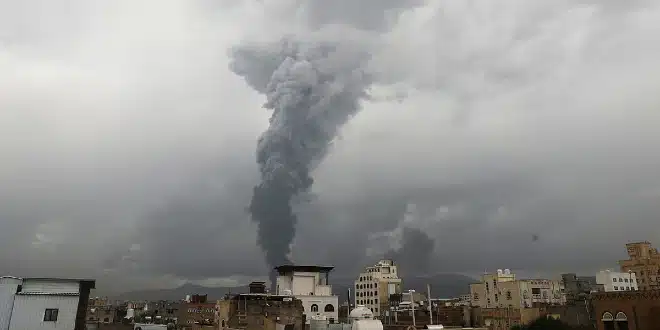Key Points
- Israeli airstrikes on Sanaa killed at least six and wounded 86.
- Targets included oil and power facilities, as well as a military site at the presidential palace.
- Houthis vowed to continue attacks, saying operations support Gaza.
- Rebels launched a cluster bomb missile at Israel last week, intercepted mid-air.
- Shipping in the Red Sea remains under threat, disrupting global trade.
- U.S. has previously struck Houthi positions but struck a deal earlier this year to limit direct confrontation.
Israeli fighter jets launched heavy airstrikes on Yemen’s capital, Sanaa, on Sunday, just days after Houthi rebels claimed to have fired a cluster bomb missile toward Israel—the first such projectile since 2023. The strikes mark an escalation in the long-running confrontation between Israel and the Iranian-backed Houthis, whose campaign of missiles and drone attacks has targeted both Israel and international shipping in the Red Sea.
Civilian Deaths and Damage in Sanaa
According to the Houthi-run health ministry, at least six people were killed and 86 others wounded in the bombardment, seven of them critically. Residents across the city reported feeling the force of the strikes, with windows shattered and homes rattled.
“The sounds of explosions were very strong,” said Hussein Mohamed, who lives near the presidential palace. Another resident, Ahmed al-Mekhlafy, told the Associated Press that “the house was rocked, and the windows were shattered” during the blasts.
The rebels’ Al-Masirah television station reported that multiple sites across Sanaa were hit, including an oil facility belonging to Yemen’s national oil company and the Hizaz power station, which Israeli officials described as “a significant electricity supply facility for military activities.” Footage shared on social media showed a massive fireball erupting from the oil plant.
Israeli strikes also targeted a military compound near the presidential palace and a closed military academy, with smoke rising above Sabeen Square, one of Sanaa’s central gathering places.
Israel’s Justification and Escalation
Israel’s military confirmed it carried out strikes on the Asar oil facility, the Hizaz power plant, and military infrastructure in the presidential compound. An Israeli Air Force official said more than 10 jets participated in Sunday’s raids.
Defense Minister Israel Katz said in a statement that Israel would continue to “impose an air and naval blockade,” while Prime Minister Benjamin Netanyahu vowed that the Houthis were “paying a heavy price for their aggression.”
The strikes were the first since last week, when Israel said it hit Houthi energy facilities used to support rebel operations.
Houthi Response and Ongoing Threats
Houthi officials pledged to continue their campaign. Nasruddin Amer, deputy head of the group’s media office, said on social media: “Our military operations supporting Gaza won’t stop, God willing, unless the aggression is stopped and the siege is lifted.”
On Friday, the Houthis claimed to have fired a newly equipped missile at Israel’s Ben Gurion International Airport. Although it was intercepted before reaching its target, Israeli officials said the projectile was particularly concerning: a cluster munition, designed to scatter multiple explosives upon impact. Such weapons are harder to intercept and, according to Israeli officials, point to new technological assistance from Iran.
Red Sea Shipping at Risk
The Houthis’ attacks are not limited to Israel. Over the past 22 months, the group has launched dozens of missiles and drones at international vessels, disrupting vital trade through the Red Sea. From November 2023 to December 2024 alone, more than 100 commercial and naval ships were targeted.
Roughly $1 trillion in global goods flows through the Red Sea annually, making the Houthis’ campaign one of the most destabilizing factors for international shipping in recent years.
Although the rebels paused attacks during a brief ceasefire in Gaza earlier this year, they resumed shortly afterward, warning they would strike vessels linked to companies doing business with Israeli ports, regardless of nationality.
U.S. Involvement and Regional Fallout
The United States has also played a significant role in the conflict. A series of American-led airstrikes last year targeted Houthi launch sites after attacks on commercial vessels. In May, Washington announced a deal with the Houthis: an end to U.S. strikes in exchange for a halt to maritime attacks. However, the Houthis insisted the agreement did not prevent them from targeting Israel or its allies.
Earlier this year, Israel carried out a rare daytime strike on Sanaa’s airport, destroying its terminal and damaging several passenger planes, including three belonging to Yemenia Airways.
What This Means
The latest escalation highlights the widening regional dimensions of the Israel–Gaza conflict. The Houthis, aligned with Iran, continue to frame their attacks as part of a broader campaign of solidarity with Palestinians, while Israel treats the rebels as an extension of Tehran’s military reach.
With the Houthis now deploying cluster munitions and Israel striking deeper into Yemen, the risk of further destabilization in both the Red Sea and the wider Middle East is growing.


